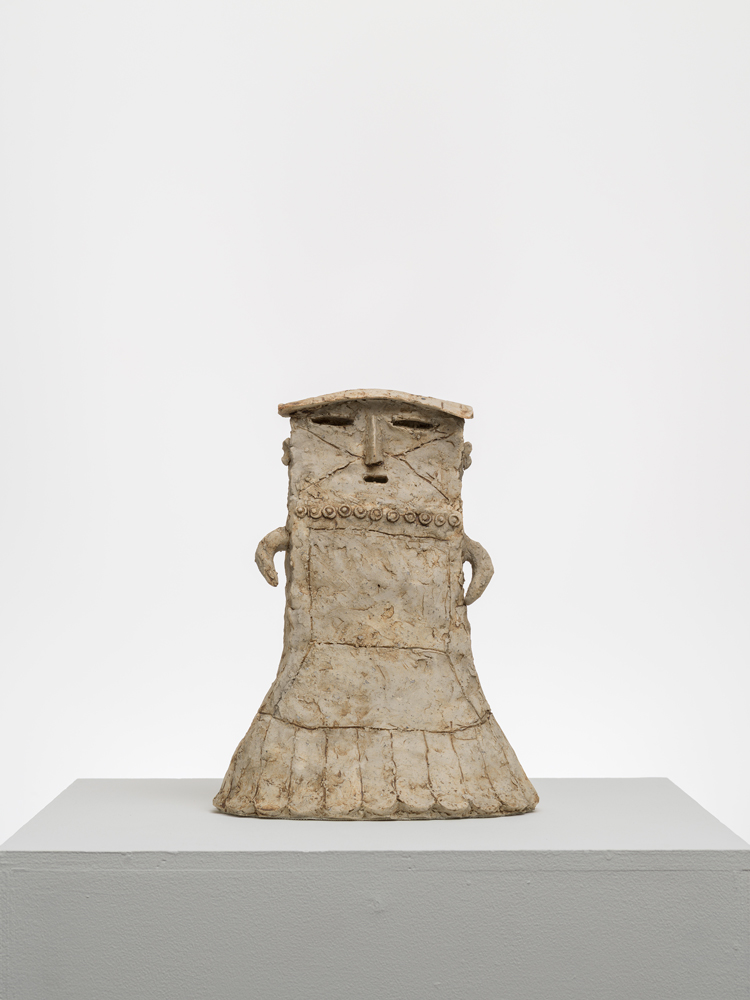Exhibition
Earthen Figure

INSTALLATION VIEW “Earthen Figure”, 2025. Courtesy of the Artist and Tomio Koyama Gallery.
Tomio Koyama Gallery is pleased to announce two solo exhibitions by Keiji Ito: “Earthen Figure” at its Kyobashi location, and “Silence and Space” at its Roppongi space. Concurrently, a solo exhibition entitled “Keiji Ito Exhibition: Tea Ceremony Utensils” will be held at Kakiden Gallery in Shinjuku (from Wednesday, October 15 through Tuesday, October 21, 2025). This presents a rare opportunity to gain a full appreciation of the multilayered world of Ito’s work.
【About Keiji Ito
A silent, profound gaze directed towards the prospect of human existence, unconstrained by existing preconceptions】
Keiji Ito (1935-), who is celebrating his 90th birthday this year, freely employs a diverse range of materials and techniques, including ceramics, oil painting, charcoal, installation, and collage, unconstrained by existing preconceptions. His work has consistently embodied his essential pursuit of the question: what is this existence we call human?
This approach is shaped by Ito’s uniquely acute sensibility and broad perspective. Childhood memories of war atrocities etched into his mind that shaped his attitude towards prayer, studying oil painting at Musashino Art School (now Musashino Art University), his fascination with both Asian and Western art, including Modigliani, Picasso, the giant boulder structures in the Asuka region of Nara Prefecture, the Asuka Daibutsu (a giant statue of Buddha), and the Buddhist statues that stand in the halls of Yakushiji temple, along with his emphasis on the importance of drawing — all of these became the foundation for his evolving artistic world.
Ito’s time at the Gifu Prefectural Ceramics Research Institute and his encounter with Sakuzo Hineno, a ceramics designer and leader of a craft movement, also had a profound influence on him. It was there that he felt a sense of the limitations involved in connecting with actual three-dimensional forms through two-dimensional designs alone, something that became the impetus for him to begin creating ceramics himself.
Shuji Takahashi, director of the Toyota Municipal Museum of Art, made the following remark regarding Ito’s work.
“(But the impression I get from his works such as Buddha’s feet and faces is that) rather than being formed in the process of feeling clay in his hands, he first visually conceives a plan; in other words, I feel that he conjures two-dimensional images, then assembles them to construct a three-dimensional form. This is not to say that one approach is better than another; it is simply a matter of each artist’s taste.” *1
Ito’s quiet, profound gaze and powerful body of work have long been critically acclaimed. Even today, at the age of 90, he continues to devote himself energetically to his work, exhibiting with increasing enthusiasm both in Japan and abroad. His exhibition “Keiji Ito: Prayer ーNow, the Future,” held at the Museum of Modern Ceramic Art, Gifu from June to September this year, showcased his artistic journey and current creative direction, winning him many critical accolades.
See the following link for more details on Keiji Ito:
https://tomiokoyamagallery.com/en/artists/keiji-ito/
【On the exhibitions in Kyobashi and Roppongi
The Indirectness and Sacredness of Ito’s Work, and the Irrepressible Restlessness of Humanity】
The solo exhibition “People of the Earth” in Kyobashi will focus on Ito’s latest works.
Ito describes how human faces generate infinite expressions from a limited combination of elementsーeyes, nose, and mouthーand how the act of bringing them “to life” brings fundamental painterly way of thinking. Culminating in recent works like Earthen Figure that convey richer expressions and greater diversity. Some figures reminiscent of haniwa and dogu (earthen figurines) recall the long history of humanity’s attempts to represent itself. *2
The solo exhibition “Silence and Space” in Roppongi will feature a progression from the 1988 work Silence — a sculptural form that simply continues to exist even as it conceals something within its closed, unified mass — to his work Place from 1995, in which Ito envisioned a “space for ritual,” and Story from 2005, which features various symbolic places arranged within a gently open interior. The exhibition also showcases works that share an underlying connection to bodily sensations, and the act of expressing a sense of humanity itself.
“We feel that the abstraction within Ito is somehow connected to indirectness and spirituality…Life and death, battle, the heart’s search for connection, prayerーthese fundamental human occupations are what compose the ambiguous layers of Ito’s work. The inability to talk about his work is somehow deeply connected to the hopeless confusion of human beings.” *3
Also running concurrently at the Kakiden Gallery in Shinjuku is the solo exhibition “Keiji Ito: Utensils for the Tea Ceremony,” showcasing over 30 tea bowls alongside larger bowls, serving dishes, and other utensils used in kaiseki cuisine. As Ito himself explains, “I believe making tableware is the best way to learn ceramic techniques,” and this exhibition reveals his approach, which is unconstrained by genres like objects or vessels.*4
There is a sense of boundless scale to Keiji Ito’s artistic universe. We hope that visitors to this exhibition will be able to encounter fundamental questions about everyday life and humanity — the very ones that often go overlooked.
*1 Shuji Takahashi ‘The Visual and the Tactile’ “Ito Keiji: Prayer ーNow, the Future” exhibition catalogue, Books Ogaki Co.,Ltd, 2025
*2 ‘Mask, Face and Human’ “Ito Keiji: Prayer ーNow, the Future” exhibition catalogue, Books Ogaki Co.,Ltd, 2025
*3 Izumi Hayashi ’Notes on the Work of Ito KeijiーForm, Place, Prayer’ “Ito Keiji: Prayer ーNow, the Future” exhibition catalogue, Books Ogaki Co.,Ltd, 2025
*4 ‘Ito Keiji – Interview in His Studio’ “Ito Keiji: Prayer ーNow, the Future” exhibition catalogue, Books Ogaki Co.,Ltd, 2025
2025. 10. 15. (Wed) – 2025. 11. 15. (Sat)
Tomio Koyama Gallery (Kyobashi)